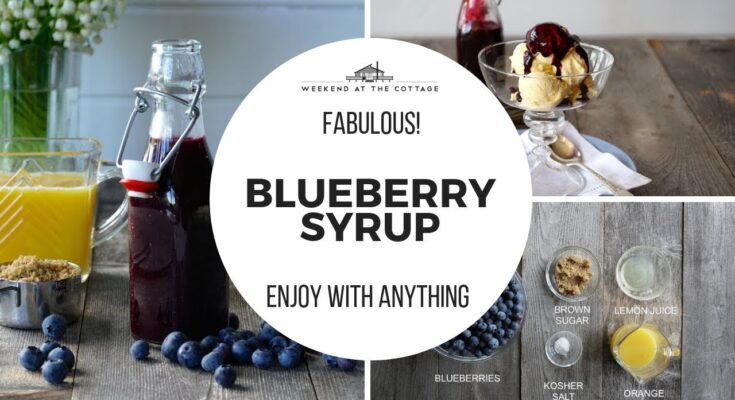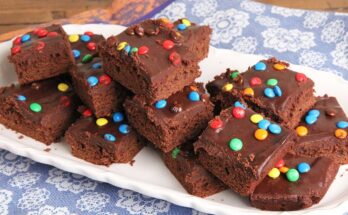Blueberry Syrup Recipe: Imagine waking up on a lazy Sunday morning and making a breakfast that feels like it came straight from a cozy farmhouse café. A stack of pancakes or waffles on your plate—steaming, buttery, and golden—and then you pour over a vibrant, glossy blueberry syrup that tastes as fresh as the berries themselves. That’s the magic of homemade.
Most store-bought syrups are loaded with artificial flavors, preservatives, and a shocking amount of sugar. Making blueberry syrup at home allows you to control everything that goes into it—from the sweetness to the texture to the quality of the fruit. It’s not just healthier, it’s more flavorful. Plus, you can tweak the recipe to match your taste, whether you like it super sweet, a bit tangy, or even spiced with a hint of cinnamon or vanilla.
Homemade blueberry syrup isn’t just for breakfast, either. It’s a multitasking marvel in the kitchen. Use it in cocktails, desserts, or even as a glaze for meats. In the next few sections, you’ll get a full breakdown of what you need and how to make your own in five simple steps.
Ingredients You’ll Need
Before we get cooking, let’s talk ingredients. The beauty of this recipe is that you don’t need anything fancy. Just a few basic items you probably already have in your kitchen. Here’s what you’ll need for a standard batch:
- 2 cups of fresh or frozen blueberries – Fresh is best for a brighter flavor, but frozen works just fine too.
- 1 cup of water – Helps to extract the juice and get the syrup to the right consistency.
- ¾ cup of granulated sugar – Adjust to taste, depending on how sweet you like it.
- 1 tablespoon of lemon juice – Brightens the flavor and helps preserve the syrup.
- Optional: cinnamon stick, vanilla extract, or a pinch of salt – For a more complex flavor profile.
The ingredient list is short and sweet, literally. You can scale it up or down depending on how much syrup you want. If you’re using this for a brunch gathering, double it. If it’s just for your weekend pancakes, the standard batch will last you a week or more.
Tools and Equipment Required
Good tools make great cooking even easier. While blueberry syrup is a simple recipe, a few kitchen basics will make the process smoother:
- Medium saucepan – You’ll be simmering the syrup here.
- Wooden spoon or silicone spatula – For stirring and mashing.
- Fine mesh strainer or cheesecloth – To strain out the solids for a smooth finish.
- Glass jar or airtight container – For storing the syrup once it’s done.
- Measuring cups and spoons – Accuracy is key when it comes to syrup consistency.
These are items most kitchens already have, but having them handy before you start will keep things moving along. If you want to get a little fancy, you can even use a funnel to pour the syrup into bottles without making a sticky mess. Pro tip: Warm the jar slightly before adding hot syrup—it prevents cracking and helps with storage.
Step-by-Step Blueberry Syrup Recipe
Alright, let’s get into the nitty-gritty. Here’s how to make the best blueberry syrup ever—smooth, rich, and bursting with berry flavor. It’s a simple five-step process, and every step brings you closer to that dreamy drizzle you’re craving.
Step 1 – Gather Your Ingredients
First things first—prep your ingredients. Wash your blueberries thoroughly if they’re fresh. If you’re using frozen, no need to thaw them fully, but give them a quick rinse to remove any ice crystals. Measure out your sugar, water, and lemon juice, and keep your optional spices nearby if you’re using them.
When choosing blueberries, go for plump, deep-colored ones. The better the berries, the better the syrup. Wild blueberries are smaller but pack more flavor, while farmed ones tend to be juicier. Both work great.
This stage is also a great time to taste a few berries. If they’re especially tart, you may want to increase the sugar slightly. If they’re super sweet, you might pull back a bit.
Step 2 – Cook the Blueberries
Once everything’s prepped, it’s time to bring the berries to life. Place your blueberries, sugar, and water into a medium saucepan. Turn the heat to medium and stir occasionally to dissolve the sugar. As the mixture begins to warm, you’ll notice the blueberries releasing their juices and the liquid taking on a deep purple hue.
You don’t want to blast the heat too high—gentle heat helps the berries break down gradually without scorching the sugar or burning the fruit. Let the mixture come to a gentle simmer. At this point, the kitchen starts to smell like blueberry heaven.
Cooking time here is usually about 10-15 minutes. Stir occasionally, and don’t walk away—sugar can burn if left unchecked. Keep an eye out for foam forming at the top. You can skim that off with a spoon for a clearer syrup.
Step 3 – Mash and Simmer
As the berries soften, it’s time to get in there with a wooden spoon or a potato masher and gently press them against the side of the pan. You’re not pulverizing them—you just want to release more of that juicy flavor.
After mashing, let the mixture simmer for another 10 minutes. This step is key because it intensifies the flavor and thickens the syrup slightly. You’ll notice the syrup starting to reduce and thicken naturally, and the aroma becomes richer.
If you’re adding a cinnamon stick or a splash of vanilla extract, now’s the time to do it. These additions infuse deeper layers of flavor into the syrup, making it taste gourmet without any extra effort.
Remember, patience is your best friend here. Letting the syrup reduce slowly makes all the difference in flavor and consistency.
Step 4 – Strain the Mixture
Once your blueberries are thoroughly cooked and the syrup is rich and fragrant, remove the saucepan from the heat. Place a fine mesh strainer or cheesecloth over a bowl or another saucepan, and carefully pour the mixture through.
This step separates the solids—those blueberry skins and seeds—from the velvety syrup. Use the back of a spoon to gently press the solids and extract as much syrup as possible. Don’t rush this part; every drop counts.
Some people prefer a slightly chunky syrup and might keep some of the pulp. That’s totally up to you. If you want it extra smooth, go for a second strain through cheesecloth.
Let the strained syrup sit for a few minutes. It will thicken slightly as it cools, giving it that perfect pourable consistency.
Step 5 – Add Lemon Juice and Bottle It Up
With your smooth syrup in a bowl or clean saucepan, stir in the lemon juice. This not only enhances the bright blueberry flavor, but it also helps the syrup keep longer. Lemon juice acts as a natural preservative and gives your syrup a little zing.
Pour the finished syrup into a sterilized glass jar or bottle using a funnel. Be careful—it’s hot. Let it cool to room temperature before sealing the lid.
Store your blueberry syrup in the refrigerator. It’ll stay fresh for up to 2 weeks. Want to keep it longer? Freeze it in small containers or even ice cube trays for single servings you can thaw as needed.
Tips for a Perfect Blueberry Syrup Every Time
Making blueberry syrup is pretty straightforward, but these tips can help you level up from “good” to “unbelievably delicious” every time.
- Taste as you go – Always try the syrup before bottling. You can adjust the sweetness or tartness with a little extra sugar or lemon juice.
- Use quality fruit – Old or bland berries won’t produce rich syrup. Frozen is fine, but opt for organic if possible.
- Simmer low and slow – Rushing the cooking process can result in a burnt taste or thin texture. Let the berries break down naturally.
- Experiment with flavors – Add cinnamon, cardamom, nutmeg, or even a splash of bourbon or balsamic vinegar for a unique twist.
- Sterilize your storage jars – Clean jars help your syrup last longer and prevent spoilage.
Mistakes happen, but they’re easy to fix. If your syrup is too thick, add a splash of water. Too runny? Simmer a bit longer. You’ve got this!
Creative Ways to Use Blueberry Syrup
You’ve made your syrup—now what? Beyond the classic stack of pancakes, blueberry syrup can be a game-changer in the kitchen. Let’s explore some fun and delicious uses:
- Breakfast Boost: Drizzle over waffles, French toast, oatmeal, or yogurt for a fruit-forward flavor pop.
- Dessert Sauce: Pour over ice cream, cheesecake, or sponge cake. It pairs beautifully with vanilla, lemon, and even chocolate.
- Cocktails and Mocktails: Mix a spoonful into soda water, lemonade, or gin and tonic. Instant blueberry fizz!
- Savory Swaps: Use as a glaze for grilled meats like pork or chicken. A little tangy sweetness goes a long way.
- Baking Buddy: Swirl it into muffins or scones before baking, or use it to flavor whipped cream or frosting.
Blueberry syrup isn’t just a condiment—it’s an invitation to get creative. Once you start using it, you’ll wonder how you ever lived without it.
How to Store and Preserve Blueberry Syrup
Once you’ve made a batch of this heavenly syrup, the next step is making sure it stays fresh and flavorful. Proper storage not only maintains the taste but also ensures safety if you plan to enjoy it over several weeks—or even months.
Refrigeration
For short-term storage, the fridge is your best friend. After bottling the syrup, let it cool to room temperature, then seal it tightly and store in the refrigerator. Properly stored, your syrup will stay fresh for about 10 to 14 days. Use clean spoons every time to avoid contamination and keep the syrup as fresh as possible.
Freezing for Long-Term Use
Want your blueberry syrup to last even longer? Pop it in the freezer. Use freezer-safe containers, leave a bit of headspace to allow for expansion, and label with the date. Another fun option is pouring the syrup into ice cube trays—this way, you can thaw single servings as needed. Frozen syrup can last up to 6 months or more without losing its flavor or texture.
Canning for Preservation
If you’re serious about stocking your pantry, consider canning your syrup. Pour hot syrup into sterilized jars, leaving about ¼ inch headspace. Process the jars in a boiling water bath for about 10 minutes. This method lets your syrup last for up to a year on the shelf—perfect for gifting or saving blueberry season’s best for later.
No matter the method you choose, proper sealing and clean utensils are crucial. Always check for signs of spoilage before use, like changes in smell, color, or texture.
Nutritional Benefits of Blueberries
Besides being delicious, blueberries are incredibly nutritious—and your homemade syrup brings along some of those health perks. Even though some of the nutrients are reduced during cooking, you still get plenty of the good stuff.
Rich in Antioxidants
Blueberries are famous for their high antioxidant content, especially anthocyanins—the pigments that give them that deep blue color. These antioxidants help fight free radicals, reduce inflammation, and may support heart health.
Low in Calories, High in Nutrients
Blueberries are low in calories but loaded with essential nutrients. They contain:
- Vitamin C – Supports your immune system
- Vitamin K – Important for blood clotting and bone health
- Manganese – Aids in metabolism and bone development
- Fiber – Promotes digestion and helps manage blood sugar levels
Heart and Brain Health
Studies have shown that blueberries can help lower blood pressure, reduce cholesterol, and improve memory function. While the syrup version has added sugar, it’s still a better alternative to artificially flavored store syrups.
Even when used in a sweet syrup, blueberries bring more than just flavor to the table—they offer a little health boost with every spoonful.
FAQs about Blueberry Syrup Recipe
Q1: How long does homemade blueberry syrup last?
Homemade blueberry syrup can last up to 2 weeks in the refrigerator when stored in an airtight container. For longer storage, freeze it in small portions for up to 3 months.
Q2: Can I use frozen blueberries instead of fresh?
Absolutely! Frozen blueberries work just as well. Just thaw them slightly and use them as you would fresh ones — the flavor stays just as bold and juicy.
Q3: How do I thicken my blueberry syrup?
To thicken the syrup, simmer it longer to reduce the liquid or add a slurry of cornstarch and water (about 1 tablespoon cornstarch to 2 tablespoons water). Stir until thickened to your liking.
Q4: Is blueberry syrup the same as blueberry sauce?
Not quite. Blueberry syrup is thinner and pourable, perfect for pancakes and drinks. Blueberry sauce is typically thicker and chunkier, great for desserts like cheesecake.
Q5: Can I can blueberry syrup for long-term storage?
Yes, you can! Use sterilized jars and process them in a boiling water bath for 10–15 minutes. This method allows you to store the syrup unrefrigerated for up to a year.
Q6: What can I serve blueberry syrup with?
Try it on pancakes, waffles, French toast, yogurt, oatmeal, cheesecake, or even mixed into cocktails and lemonades. It’s a versatile kitchen superstar!
Conclusion
There’s something incredibly satisfying about making your own blueberry syrup from scratch. It’s simple, budget-friendly, and it fills your kitchen with the comforting scent of fresh berries simmering on the stove. The process is fun and the end result? Pure joy in a jar.
From fluffy pancakes and desserts to cocktails and glazes, this syrup isn’t just a topping—it’s a kitchen essential. And once you’ve tried it homemade, there’s no going back to store-bought. You’ve got the steps, the tips, and even a few creative uses up your sleeve now. All that’s left to do is gather your berries and get cooking.
Don’t be surprised if this becomes a staple in your home—you might even start making it in double batches!



